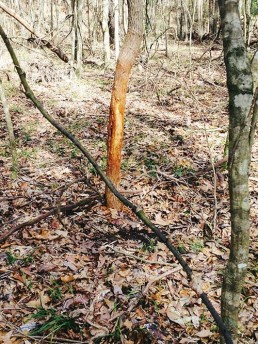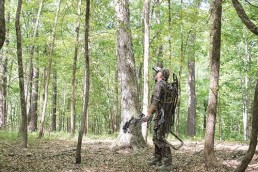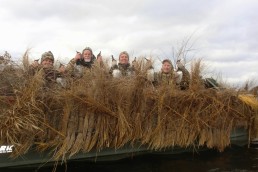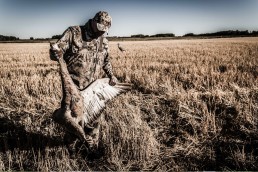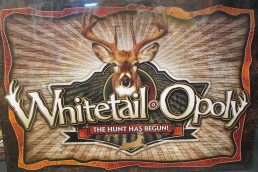Hunting the October Lull
SHARE THIS POST
Fall is in the air. Bow season has opened in some states and by October 1, it’s open everywhere. Hunters have been glassing fields in the evenings and watching deer consistently come to feed. Ambush stands have been strategically placed.
If you’ve done your homework, the hunting can be good at first. But then comes the most talked about and dreaded period of bow season. It happens every year—deer sightings diminish and can go to literally seeing none. They’ve seemed to “disappear” or “crawl into a hole,” as some hunters say. What’s going on?
They call it the “October Lull.”
This span of archery season usually starts during the second week of October and lasts around two and a half weeks, even longer on some years.
There’s a lot of skepticism about the lull—most hunters complain about it but don’t understand what it is. The lull is real, from one perspective. Deer sightings will go down from the beginnings of archery season. But from another point of view, the lull can become nonexistent and a great opportunity to bag your deer.
Don’t buy into all the negativity of the lull. The deer haven’t disappeared. They are simply in a transition period. Both does and bucks are moving from summer patterns to fall patterns. They’re still out there every day doing what deer do: bedding, feeding, watering, and traveling between stops. They’re simply doing these things in different places than the season opener.
If you can recognize what’s happening on your hunting property, you’ll be able to change tactics and adjust. Below are four major things to look for that cause deer to change their patterns, creating what can be a “lull” in deer sightings.
The pressure is on
People put pressure on deer. Deer avoid contact with humans. We all know if you spook a deer and bump him, his behavior and normal pattern will be altered. The influx of anyone’s scent in deer territory will change where they travel and when they travel. It will turn the deer’s daytime appearances nocturnal quickly.
Hunting pressure is one thing that alerts deer to human presence. Frequenting the same stand too much, going to your favorite stand with the wrong wind, setting up too close to bedding areas, and riding ATVs too close to hunting spots are all good ways to let the deer know that hunting season has arrived.
It’s not only bowhunters with bad habits that will educate deer—it’s firearms hunters as well. Most times, gun hunters who do not bowhunt will wait until October, when it cools down, to prepare for their upcoming hunting season. They’ll trim shooting lanes, put up new stands, cut trails, and repair shooting houses. Just a few things our fellow hunters will do, and it’s clear how this can affect deer.
Other hunters are out and about contributing to the changing patterns of our deer. Rabbit, squirrel, pheasant, fall turkey, dove, and waterfowl hunting are all going on at the same time. There are small game hunters walking around, shooting, talking loud, and calling dogs. Their education of our quarry is unintentional, but that’s just the way it is.
Trail cameras are a good scouting tool, but if not done wisely, will put stress on deer the same as bad hunting habits. Check or run them in the middle of the day and no more than once a week. If you can check them right before a rain, this will help kill any scent you’ve left behind.
The bottom line is to know what’s happening on your property. If you hold the lease, you should be able to control what happens on your hunting ground. If you have to share the property with others, learn who will be there, when, and what they are doing. This will help you figure out how the deer will be affected and avoiding any pressured areas.
Food sources change
Late summer and going into early fall the deer will likely be in a field pattern in most Midwest states. Soybeans are a favorite and they can be spotted most evenings feeding here. They’ll also be in the standing corn—feeding and bedding. Deer eat alfalfa all summer long.
When the corn and beans are cut, deer will still frequent the fields to get anything left by the pickers and spillages. They’ll also go after cut alfalfa as long as it stays green.
With early fall comes all the pressures mentioned above with human activity. Along with both hard and soft masts starting to fall, the deer will quickly change patterns and abandon the fields till well after dark. They are now transitioning from a field pattern to a browsing pattern.
Are you enjoying this post?
You can be among the first to get the latest info on where to go, what to use and how to use it!
Deer are selective browsers and will keep moving, for the most part, feeding on what has the most nutrition for their needs at different times of the year. During the fall deer are starting to feed on foods with more carbohydrates getting ready for higher energy demands of the soon coming rut —this means acorns for October.
Deer prefer acorns for food over just about anything else, including corn. If there’re acorns to be had—the deer will have them. Their most favorite is the white oak acorn. They’re sweeter tasting and deer will choose them over red oak acorns. Deer like them right after they’ve fallen and are still green.
If you want to find the “sweetest of the sweet” white oak acorns, look for white oak trees that are located on fence rows of agricultural fields. These trees reap the benefit of the fertilize broadcast for the crop or hayfield. They’ll be really healthy and delicious. Soft mast is also a food source deer will go after during the lull period. Some common types are: persimmon, crabapple, honey locust, and domestic pear and apple. Although acorns are the staple this time of year, soft mast is the candy and deer will devour it.
You have to know where all the hard and soft mast food sources lie on your hunting property. This is a key step in pattering where the deer are frequenting. Knowing this will help you adjust your strategy and get on top the deer.
Bedding areas change
Deer bedding areas will change during their transition from summer patterns to fall patterns. There’re several reasons for this. Pressure and changing food sources contribute to deer using new bedding areas, but there’s another reason they’ll seek new places to bed.
Common sense tells us that too much pressure on deer will cause them to go to other bedding areas. Deer will no longer bed along fence rows of agricultural fields if they’re spooked by deer hunters on the way to a stand, small game hunters, or any human activity. If you get too close to a bedding area scouting or checking cameras and bump deer more than once, you’ll change their bedding habits.
The changing food sources are more of a contributing factor than pressure when it comes to new bedding areas. All deer haven’t been bumped or scared away from their bed, but all deer do prefer eating acorns. Deer will definitely bed as close as possible to the acorns they’re feeding on. This can change several times throughout the lull period. When their favorite acorns run out, they’ll adjust and find new ones. They’ll bed as close as possible where they feel safe.
One more important factor to consider is due to the changing seasons. The sun is moving toward the southern hemisphere and days are starting to get cooler. Deer will start to bed on south facing slopes so they can soak up some sunlight, especially on cold days. Mature bucks will bed with their backs to the wind. They’re able to detect danger with their noses from behind and watch below them at the same time. When there’s a north wind, south facing slopes are perfect bedding spots.
Bucks transition to pre-rut
The lull is time of year that bucks start to realize that the rut is not far away and causes a significant shift in deer patterns. The bachelor groups are busting up and summer long friendships are coming to an end. Although you’ll still see some young bucks together, more mature bucks start spending time alone. This is when hooked trees and fresh rub-lines will appear; sparring starts taking place and pecking orders begin to establish.
Does and yearlings will still hang out in groups and sometimes year-and-a-half old bucks will congregate with them. By the very end of the lull, the older bucks will start to frequent food sources at the same times and places the does like to hang out. On a good day, you may even catch a mature buck coming in to mix it up with the group.
Tips for success
You’ll have to be willing to adjust with the deer as they change patterns to be successful during the lull—be ready to move. A climbing stand is a good way to be mobile. As food sources and bedding areas change, you can scout for fresh falling acorns, hang your climber and hunt. I’ve actually scouted with my stand on my back and bow in hand, hung the stand, and harvested a buck on the same afternoon.
If you do this, hunt close to or on the food source and stay away from bedding areas. The best chance you have to bag a deer is the first time you make a hunt from a new location.
Hang a stand on fresh trails with plenty of sign or on fresh rub lines and try some morning hunts. The evenings are not always the best time to get a shot on a deer. I’ve just realized in the past five years how successful morning bow hunts can be.
If you have to make a scouting trip into your hunting terrain, leave as little impact as possible. Scout during the middle of the day while deer are bedded. Try to plan a scouting trip right before or during a rain, just like you want to do when checking game cameras.
Summing it up
These four things combined change deer behavior every year. Each is as important as the other. The sudden intrusion of man into deer habitat, combined with changes in food sources and bedding areas, plus the onset of the pre-rut, combine to alter deer behavior dramatically. If you’re not willing to abandon your favorite early bow season stand sites, the October Lull can become a reality for you.
Most hunters don’t look forward to the October Lull. But, when deer start to make the transition and you adapt to their changes, you will see more deer and you can find success. I’ve adapted and love this time of year, and you can, too. Like many other successful bowhunters, you might begin to think that the October Lull is a mere myth.
MWO
SHARE THIS POST
Did you enjoy this post?
You can be among the first to get the latest info on where to go, what to use and how to use it!
Andy Douglas
Andy Douglas is an avid hunter, outdoor writer, and photographer. He has been chasing whitetails, big toms, bass, and most game that can be had for over 35 years. He lives the outdoor lifestyle and is passionate about sharing with others through stories and photos. Email him at AndyDouglas.Outdoors@yahoo.com
